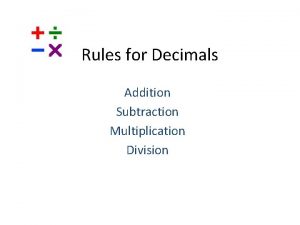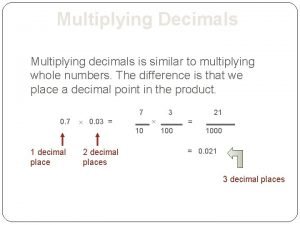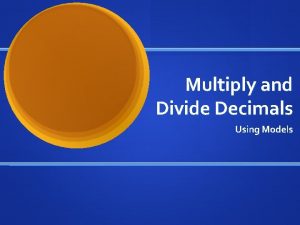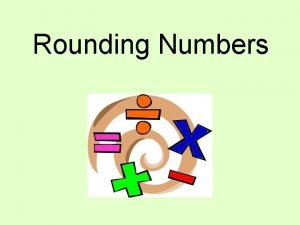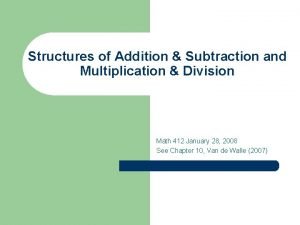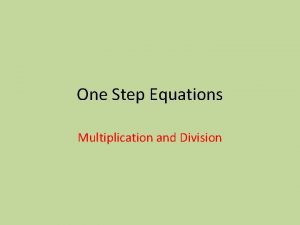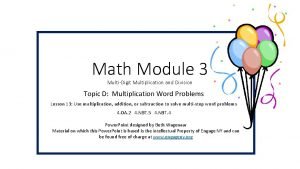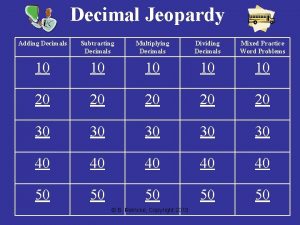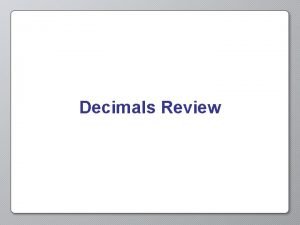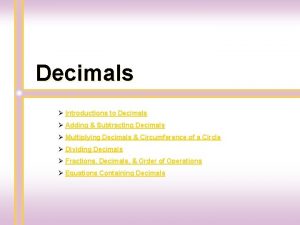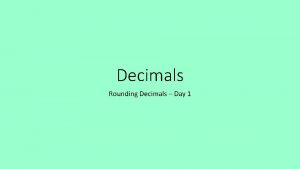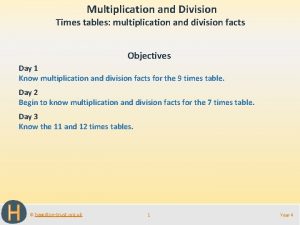Rules for Decimals Multiplication Division Rules for Multiplication












- Slides: 12

Rules for Decimals Multiplication Division

Rules for Multiplication 1. Line up your numbers with the last digits under each other. 2. Multiply as you would with whole numbers. 3. Add the decimal places in each of the numbers being multiplied. 4. Move the decimal point to the left the TOTAL number of places in the numbers being multiplied.

Rules for Multiplication - Example 1. Line up your numbers with the last digits under each other. x 12. 3 6. 11 ___________________

Rules for Multiplication - Example 2. Multiply as you would with whole numbers. x 1 2. 3 6. 1 1 ___________________ 1230 + 73800 ___________________ 75153

Rules for Multiplication - Example 3. Add the decimal places in each of the numbers being multiplied. x 1 2. 3 6. 1 1 ___________________ 1230 + 73800 1 decimal place 2 decimal places _________________________ NEEDS ___________________ 75153 3 decimal places

Rules for Multiplication - Example 4. Move the decimal point to the left the TOTAL number of places in the numbers being multiplied. x 1 2. 3 6. 1 1 ___________________ 1230 + 73800 1 decimal place 2 decimal places _________________________ NEEDS ___________________ 7 5. 1 5 3 3 decimal places

Rules for Division 1. Move the decimal point in the divisor (the number outside the box) to the right to make it a whole number. 2. Move the decimal point in the dividend (the number inside the box) to the right the same number of places. 3. Divide as you would with whole numbers. 4. Move the decimal point into the quotient (your answer) directly above the decimal point you moved in the dividend.

Rules for Division – Example 1. Move the decimal point in the divisor (the number outside the box) to the right to make it a whole number. 1. 6 5. 76 Becomes 16 57. 6 Move the decimal point one point to the right

Rules for Division – Example 3. Divide as you would with whole numbers 36 1 6 5 7. 6 Ignore the decimal point for now! - 48 96 96 0 4. Move the decimal point into the quotient (your answer) directly above the decimal point you moved in the dividend. 3. 6 1 6 5 7. 6

Division – Another Example What happens to the dividend when there are no more numbers to move the decimal place to? Example 1: 8 ÷ 1. 6 OR 1. 6 8 Since there is one decimal place in the divisor, we need to move the decimal point in the dividend and the divisor to the right one. How can we do this? 1. 6 8. 0 Remember we can add 0 s after the decimal point without changing the value of the number.

Division – Another Example Now we can solve as usual. 1. 6 8. 0 becomes 5. 16 80. - 80. 0. Which equals 5

Division – Another Example 7. 15 ÷ 32. 5 or 32. 5 7. 15 Move the decimal places one place to the right. . 2 2 3 2 5 7 1. 5 - 650 0
 Decimal division rule
Decimal division rule How to multiply decimals
How to multiply decimals Lattice method calculator
Lattice method calculator Lattice multiplication decimals
Lattice multiplication decimals Multiplying decimals with models
Multiplying decimals with models Lattice box multiplication
Lattice box multiplication Dividing decimals examples
Dividing decimals examples Rules of rounding off numbers
Rules of rounding off numbers Maths addition subtraction multiplication division
Maths addition subtraction multiplication division One step equation multiplication
One step equation multiplication Multiplication and division properties
Multiplication and division properties Multiplication and division jeopardy
Multiplication and division jeopardy 13773x
13773x
